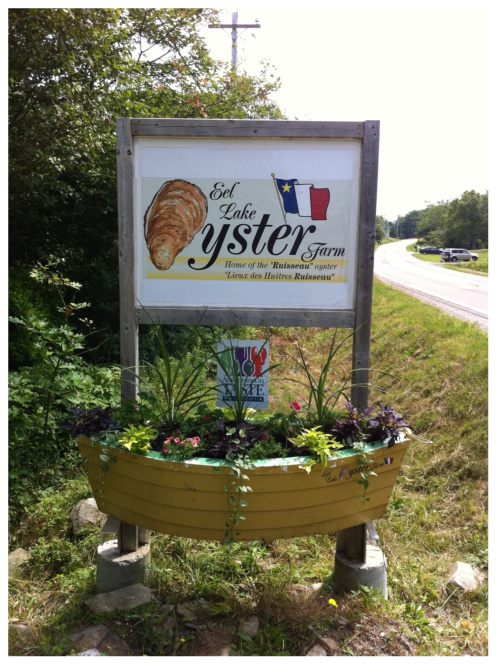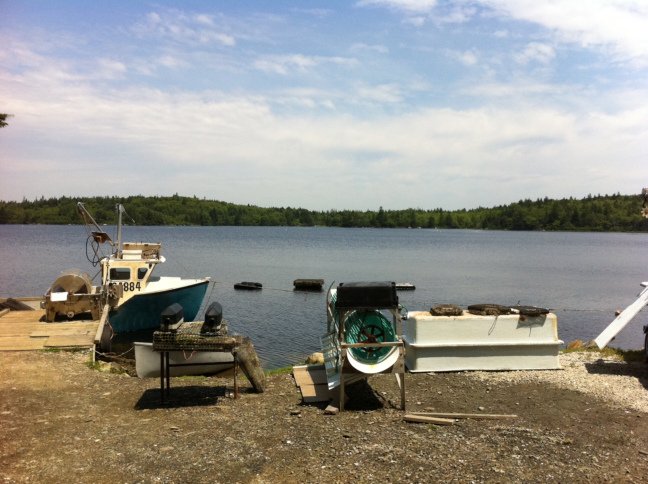Oysters, Eels and Seals: Oh My

Ah, the Oyster. There’s something slightly mysterious about these little creatures that make you work so hard to enjoy them. And the oyster is so special that a unique tool had to be designed especially to crack it open – surely a sign of something worthy! So when my husband and I had the opportunity to get a close-up look at oyster harvesting and production (and we really, really hoped some oyster sampling!) at Eel Lake Oyster Farm, we jumped at the opportunity.
As we made our way around the lakes and roads around the Southern tip of Nova Scotia, we were in awe of just how beautiful this part of the province is. We turned down a gravel road towards the Eel Lake Oyster Farm and we were warmly greeted by Colton D’Eon and his uncle Marc.
The operation at Eel Lake is very family-centered and is owned by Colton’s parents, Kim and Nolan. I was excited to head out on the boat and see the first steps in harvesting the oysters from the water and onto the plate in front of me. As I pulled on my rubber boots, the city girl in me actually asked if oysters were farmed – I think even my husband was embarrassed to be seen with me at that point!
Eel Lake
As we headed out on the lake, Colton explained to me the uniqueness of oysters from Eel Lake. Not only are the oysters grown here of a unique variety, the Ruisseau Oyster for all you keeners out there, but the unique salinity of the lake water meeting ocean water makes it especially good growing for filter feeders like oysters.
Everything is bigger in Eel Lake – the oysters that are harvested, the fish that inhabit the lake, the eels themselves and even the seals that make their way into the lake to snack on the extra large fish. A word to the wise for any of those who aren’t familiar with eels: they look like snakes. Water-loving snakes. And they love oyster pots. I got a little too close while taking a look at pot of baby oysters, and one jumped out. Hilarious.

Harvest
As we approached the oyster bed, I could see rows on rows of stacked floating, black tubes – we were approaching the oyster nursery. Marc explained to me that this method was an adaptation of traditional harvesting methods – it lets the oysters maximize their growing time in the rich, nurturing waters of the lake.
Oysters take a great deal of work to develop, especially in their early stages. The same lake that helps oysters to grow quickly, also means rapid growth for clusters of mussels that can take over pots of young oysters. Each pot is pulled up and clusters of mussels removed before they can latch on and smother the oysters.

The Oysters
We were lucky enough to be able to see oysters in several stages of growth – which is no simple feat. Oysters take 3 years to reach full maturity to take to market, which makes the unique conditions in the lake ideal for not only producing high quality oysters, but having an impressive turn around time in their production. The shape of the Ruisseau oyster is especially attractive; a deep oval shape means lots of room to collect the wonderful brine and keeps the oysters so tender.
We moved on to a third group of pods – this was the most interesting part of being out on the water. With oysters being filter feeders, the quality of their water is a key component of their health and their marketability. The uniqueness of this lake is not only important to the oysters that are grown here, but for oysters affected by disease or unfavorable growing conditions in other regions. The affected oysters are shipped to Eel Lake and are set out in pots to help flush toxins from their systems. This process takes about 14 days and the oysters are then re-tested and often available to put back on the market. It’s really oyster rehabilitation!
It’s All About the Quality
 After an amazing trip out on the boat, we came back to the dock and were shown the oyster processing process. The oysters are removed from their pots and are moved by conveyer belt up to a large drum sitting on the shore that sorts the oysters. Oysters that aren’t big enough for sale can be placed back in pots and sent back out to the lake; those that make the cut are cleaned and moved for storage and packing. All of this work is done on site, and the oysters are shipped from this location as well. The processing and packing building had several flats of oysters, packed and labelled for shipping.
After an amazing trip out on the boat, we came back to the dock and were shown the oyster processing process. The oysters are removed from their pots and are moved by conveyer belt up to a large drum sitting on the shore that sorts the oysters. Oysters that aren’t big enough for sale can be placed back in pots and sent back out to the lake; those that make the cut are cleaned and moved for storage and packing. All of this work is done on site, and the oysters are shipped from this location as well. The processing and packing building had several flats of oysters, packed and labelled for shipping.
Each flat of oysters for commercial sale contains 400 oysters –another excellent indication of the quality and speed under which these oysters are grown and harvested.
The Taste Test
At this point we had reached, what really was for me something I had been waiting for since turning down the driveway – an opportunity to try some of these delicious looking beauties! Marc was kind enough to grab a handful and shuck them right in front of us. The first thing I noticed was the size of the oyster – it was massive and meaty, with a delicious and salty brine. But hands down the best part of the oyster? The sweetness. Out. Of. This. World. And perfect just as it was – no lemon, no hot sauce. Just me and my massive oyster. My first question for Colton, once I didn’t have my mouth full of oyster, was whether they could do smaller orders. Say if I wanted to have several of my several of my closest friends over and only serve them oysters – would that be possible? No worries, it can be done!
 The People
The People
Even with the opportunity to go out on the boat, see the oyster growing process and sample the oysters, the best part of a trip like this is really getting the opportunity to meet people who produce such wonderful products and who make themselves available to share what they do. And it gives everyone a better opportunity to know where their food comes from, and the quality of products that come from Nova Scotia. So hats off to the D’Eon family, their hospitality, Eel Lake and the little Ruisseau oyster!


Fantastic article! Congratualtions to the D’Eon family for their many years of hard work and persistance. Loved those oysters cooked in bacon and brie at your Open House. C & D Vail
Great post, I’d love to do the same this fall, it’s actually more appealing than a vineyard tour…mmm oysters.